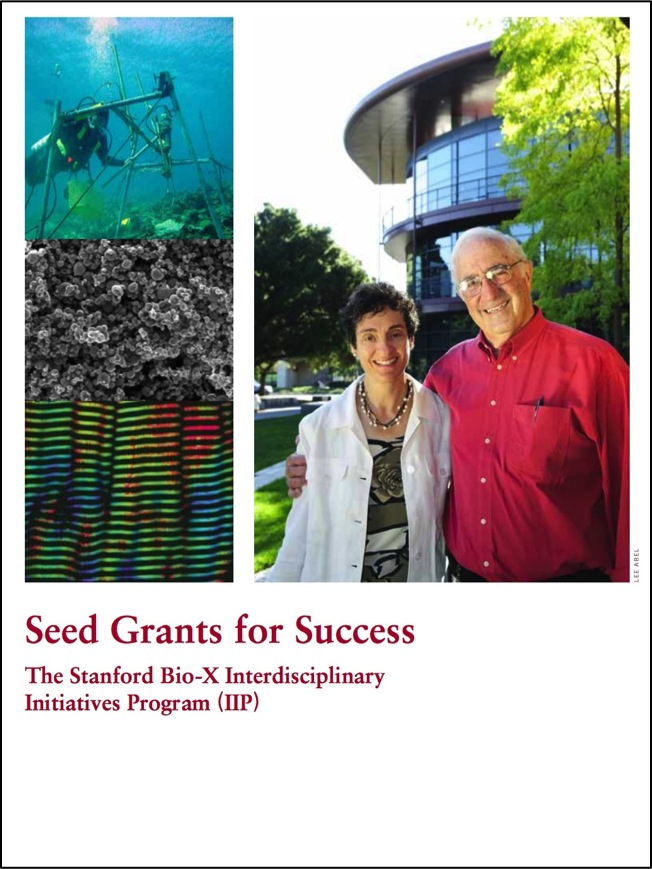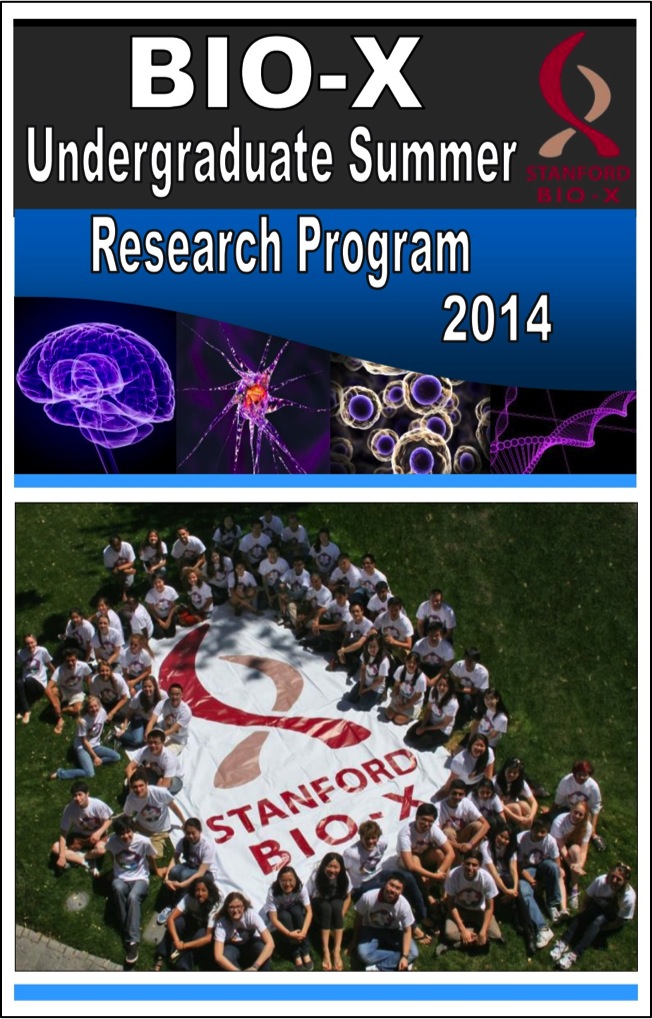
Welcome to the biweekly electronic newsletter from Stanford Bio-X for members of the Bio-X Corporate Forum. Please contact Dr. Hanwei Li, the Bio-X Corporate Forum Liaison if you would like to be added or removed from this distribution list, or if you have any questions about Stanford Bio-X or Stanford University.
Highlights
** On October 9, 2013, Bio-X celebrated the 10th Anniversary of the James H. Clark Center, the hub of Bio-X. Check out CLARK CENTER @ 10X as well as the Bio-X Timeline over the last 15 years!!
** Check out the article by Stanford President John Hennessy in the Nov/Dec 2013 issue of the Stanford Magazine on Bio-X and the Clark Center, "A Cauldron of Innovation".
Bio-X Core Programs
 SEED GRANTS FOR SUCCESS - Stanford Bio-X Interdisciplinary Initiatives Program (IIP) SEED GRANTS FOR SUCCESS - Stanford Bio-X Interdisciplinary Initiatives Program (IIP)The Bio-X Interdisciplinary Initiatives Program represents a key Stanford Initiative to address challenges in human health. Currently, the IIP awards approximately $4 million every other year in the form of two-year grants averaging about $200,000 each. From its inception in 2000 through the beginning of the seventh round in 2014, the program has provided critical early-stage funding to 164 different interdisciplinary projects, involving collaborations from over 750 faculty members, and creating over 700 teams from six different Stanford schools. From just the first 6 rounds, the IIP awards have resulted in a 10-fold-plus return on investment, as well as hundreds of publications, dozens of patents filed, and most importantly, the acceleration of scientific discovery and innovation. In 2014, Bio-X started it's 7th round of the Bio-X IIP Seed Grants Program, and 22 newly awarded projects were selected from 142 Letters of Intent (LOIs)! This has been the largest number of LOIs that Bio-X has received. Please go here to check out the newly awarded projects. Competition was intense, and the selection criteria included innovation, high-reward, and new interdisciplinary collaborations. (To view the 142 other IIP projects that have been funded from the previous 6 rounds, please click here.) |
 Bio-X FELLOWSHIPS Bio-X FELLOWSHIPSEvery year, graduate students and postdoctoral scholars of Bio-X affiliated faculty are highly encouraged to apply for the Bio-X Fellowships, which are awarded to research projects that are interdisciplinary and utilize the technologies of different fields to solve different biological questions. Students are encouraged to work collaboratively with professors of different departments, thus creating cross-disciplinary relationships among the different Stanford schools. Our fellows have conducted exciting research, resulting in publications in high-impact journals and have been offered excellent positions in industry and academia. To date, Stanford Bio-X has a total of 173 Fellows. The winners of the 2015 PhD Fellowship program will be announced later on this year on October 6, 2015 during our Fellows Symposium. The full agenda for the symposium is also listed below under "Events". IF YOU'D LIKE TO ATTEND, PLEASE EMAIL DR. HANWEI LI. You can view the numerous Fellowship projects that have been awarded over the years as well as oral presentations from previous symposiums here. |
 Bio-X UNDERGRADUATE SUMMER RESEARCH PROGRAM Bio-X UNDERGRADUATE SUMMER RESEARCH PROGRAMThe Bio-X Undergraduate Summer Research Program (USRP) supports undergraduate research training through an award designed to support interdisciplinary undergraduate summer research projects. The program is an invaluable opportunity for students to conduct hands-on research, learn how to carry out experiments in the laboratory, and develop the skills to read and analyze scientific literature. This program is eligible to Stanford students who want to work in the labs of Bio-X affiliated faculty. This year, nearly 160 students applied to the program, and 65 students were selected. Therefore, to date, 371 awards have been given to the Stanford undergraduate community to participate in the Bio-X Summer Research Program. The 2015 USRP officially ended during the last week of August, culminating in the USRP participants presenting their summer's research work during the poster session of last week's Bio-X IIP Seed Grant Symposium. In addition, during the 10 weeks of USRP, a total 30 different Faculty Talks took place on the 10 Wednesdays in Clark Center's S360 where the USRP students had the opportunity to learn about other faculty's research. To learn more about USRP and the Faculty Talks, please email Dr. Hanwei Li. |
COLLABORATIONS: We are cultivating and are highly successful in building meaningful collaborations with numerous corporate colleagues. New collaborations through our core programs are highly encouraged. To learn about how to get involved, please contact Dr. Hanwei Li, or Dr. Heideh Fattaey.
SYMPOSIUMS: Bio-X also holds symposiums every year that highlight our core programs. Thanks to all who came and attended the latest Bio-X IIP Seed Grants Program Symposium on August 26, 2015! It was extremely successful with 8 fantastic talks, and 170 posters presented during the reception (the largest poster session yet!). Nearly 400 people were in attendance of the event, with numerous discussions taking place throughout the event. Please go here to view the agenda and poster title list. Talks that were allowed to be videotaped will be uploaded as soon as possible.
All symposiums are listed on our website, including past IIP Seed Grants Program Symposiums, past Fellows Symposiums, and past Annual Symposiums.
If you'd like to learn more about the symposiums or any of the projects that were presented during the symposiums, please contact Dr. Hanwei Li with your questions.
News

 Cancer nanotechnology center to receive more than $9 million
Cancer nanotechnology center to receive more than $9 million
Bio-X Affiliated Faculty Sam Gambhir and Shan Wang
The National Cancer Institute has awarded nearly $9.5 million to the Center for Cancer Nanotechnology Excellence in Translational Diagnostics at Stanford. The five-year grant is the third award from the NCI to fund the center. The awards are managed by the NCI’s Alliance for Nanotechnology in Cancer, and are meant to bring together researchers from across different disciplines to use emerging nanotechnology advances to aid in early cancer diagnosis, monitoring and therapeutic intervention. Stanford is one of only four institutions across the country that have received all three rounds of funding.
 Tension helps heart cells develop normally in the lab, according to Stanford engineers
Tension helps heart cells develop normally in the lab, according to Stanford engineers
Bio-X Affiliated Faculty Beth Pruitt
Project received Bio-X IIP Seed Grant Program support
The heart is never quite at rest, and it turns out that even in a lab heart cells need a little of that tension. Without something to pull against, heart cells grown from stem cells in a lab dish fail to develop normally. In addition to discovering the important role that tension plays in growing heart cells outside of the body, Stanford engineers have found that lab-grown heart cells contract more strongly when grown in long, thin shapes. Beth Pruitt, an associate professor of mechanical engineering and senior author on the study, said that stem cells have held promise as a source of human heart cells, and for almost a decade scientists have been able to grow them into beating structures in the lab. "But getting them to look like normal human adult heart muscle cells has been difficult," she said. These findings are also important for scientists who have hoped to use human heart cells as a way of testing drugs for side effects before they are prescribed to people. Drugs are traditionally tested in animal heart cells, but given the many differences between humans and animals, those cells don't always detect drugs that could damage human hearts. Pruitt and postdoctoral scholar Alexandre Ribeiro reported the biomechanical conditions for producing normal adult heart cells in the lab in the September 28 Proceedings of the National Academy of Sciences, along with colleagues at the University of California, San Francisco, and the Gladstone Institutes.
 Stanford engineers create artificial skin that can send pressure sensation to brain cell
Stanford engineers create artificial skin that can send pressure sensation to brain cell
Bio-X Affiliated Faculty Zhenan Bao
Stanford engineers have created a plastic "skin" that can detect how hard it is being pressed and generate an electric signal to deliver this sensory input directly to a living brain cell. Zhenan Bao, a professor of chemical engineering at Stanford, has spent a decade trying to develop a material that mimics skin's ability to flex and heal, while also serving as the sensor net that sends touch, temperature and pain signals to the brain. Ultimately she wants to create a flexible electronic fabric embedded with sensors that could cover a prosthetic limb and replicate some of skin's sensory functions. Bao's work, reported today in Science, takes another step toward her goal by replicating one aspect of touch, the sensory mechanism that enables us to distinguish the pressure difference between a limp handshake and a firm grip. "This is the first time a flexible, skin-like material has been able to detect pressure and also transmit a signal to a component of the nervous system," said Bao, who led the 17-person research team responsible for the achievement. Benjamin Tee, a recent doctoral graduate in electrical engineering; Alex Chortos, a doctoral candidate in materials science and engineering; and Andre Berndt, a postdoctoral scholar in bioengineering, were the lead authors on the Science paper.
 Stanford biologists crack centuries-old mystery of how cell growth triggers cell division
Stanford biologists crack centuries-old mystery of how cell growth triggers cell division
Bio-X Affiliated Faculty Jan Skotheim
Cells were discovered in 1676, and almost immediately afterward scientists began wondering why cells are so perfectly small. More than three centuries later, a team of Stanford biologists have zeroed in on a previously unknown mechanism within the cell growth cycle that controls cell size. The fundamental finding was made by studying yeast cells, but could provide insight to basic human biology as well as diseases such as cancer that thrive by manipulating this mechanism. The finding is published in Nature. Cells of all types seemingly "know" just how large to grow, and when they reach that determined size, they divide into new cells. With no clear answer for what triggers this cellular decision, Jan Skotheim, an associate professor of biology at Stanford, began searching for the mechanism nearly a decade ago.
 Distinctive contexts critical to how children learn words, Stanford study reveals
Distinctive contexts critical to how children learn words, Stanford study reveals
Bio-X Affiliated Faculty Michael Frank
Children learn words best when they are used in a context that is coherent and distinctive, new Stanford research shows. This context is critical for understanding why some words may be easier for kids to learn than others, according to the new study by Michael Frank, an associate professor of psychology at Stanford, and scholars at MIT. The study, titled "Predicting the Birth of a Spoken Word," appeared in the journal Proceedings of the National Academy of Sciences. According to Frank, the study goes beyond simply addressing how often a child is exposed to a word to where and how the child hears the word. In doing so, he said, it provides evidence that what really matters for word learning is that words be used in a context that is distinctive for the child so that he or she can more effectively decode what the speaker is trying to say. In sum, words used in distinctive ways or in specific routines were learned and used by the child earlier than words that were said more frequently. "Our work develops ways of measuring other aspects of the words the child hears, by using measurements of where, when and in what context the words were used to reveal how they are used in routines like book reading, mealtimes or diaper-changing," Frank said.
 Elevated blood-sugar levels in pregnancy tied to baby's heart-defect risk
Elevated blood-sugar levels in pregnancy tied to baby's heart-defect risk
Bio-X Affiliated Faculty Gary Shaw
Pregnant women with elevated blood-sugar levels are more likely to have babies with congenital heart defects, even if their blood sugar is below the cutoff for diabetes, according to a new study from the Stanford University School of Medicine and Stanford Children’s Health. The study, published online Oct. 12 in JAMA Pediatrics, extends the scope of prior findings on the connection between maternal diabetes and fetal heart defects. It is the first to show the link in women without a diabetes diagnosis. “Diabetes is the tail end of a spectrum of metabolic abnormalities,” said James Priest, MD, the study’s lead author and a postdoctoral scholar in pediatric cardiology. “We already knew that women with diabetes were at significantly increased risk for having children with congenital heart disease. What we now know, thanks to this new research, is that women who have elevated glucose values during pregnancy that don’t meet our diagnostic criteria for diabetes also face an increased risk.” Priest treats patients with congenital heart defects at the Children’s Heart Center at Lucile Packard Children’s Hospital Stanford.
Events
| Bio-X October 27, 2015, 12:15 pm - 1 pm Clark Center, S361, Stanford, CA Frontiers in Interdisciplinary Biosciences Pre-Seminar for "Nerve-Stem Cell Interactions During Organ Development and Regeneration" Speaker: Dr. Michelle Monje, Stanford |
Bio-X October 29, 2015, 12:15 pm - 1 pm Clark Center S360, Stanford, CA Frontiers in Interdisciplinary Biosciences: "Nerve-Stem Cell Interactions During Organ Development and Regeneration" Speaker: Dr. Sarah Knox, UCSF |
Resources
| Stanford University |
| Stanford Bio-X |
| Bio-X Seed Grants The Stanford Bio-X Interdisciplinary Initiatives Program (IIP) provides seed funding for high-risk, high-reward, collaborative projects across the university, and have been highly successful in fostering transformative research. |
| Office of Technology and Licensing "Techfinder" Search the OTL Technology Portal to find technologies available for licensing from Stanford. |
| Stanford Center for Professional Development - Take advantage of your FREE membership! - Take online graduate courses in engineering, leadership and management, bioscience, and more. - Register for free webinars and seminars, and gets discounts on courses. |
| Stanford Biodesign Video Tutorials on how FDA approves medical devices A series of video briefs recently produced by the Stanford Biodesign Program teaches innovators how to get a medical device approved for use in the United States. This free, online library of 60 videos provides detailed information on the Food and Drug Administration regulatory process, short case studies and advice on interacting with the FDA. |
To learn more about Stanford Bio-X or Stanford University, please contact Dr. Hanwei Li, the Bio-X Corporate Forum Liaison, at 650-725-1523 or lhanwei1@stanford.edu, or Dr. Heideh Fattaey, the Executive Director of Bio-X Operations and Programs, at 650-799-1608 or hfattaey@stanford.edu.

